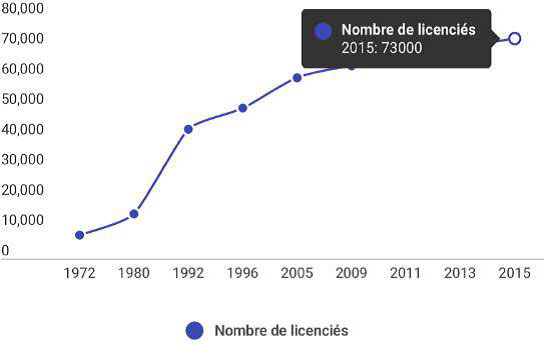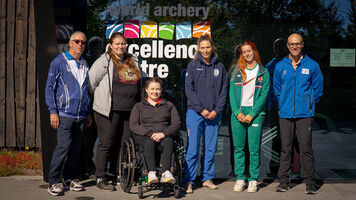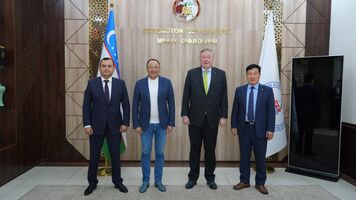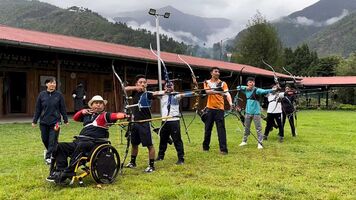French archery hits double size of federation at Flute’s win
Credit statistical tables and videos: FFTA Communication Service
In 1992, there were 36,700 archers registered with the federation. One year later, that jumped to 43,700. With the counter showing 74,649 on 22 June 2016, the 75,000 mark is fast approaching, as well as the French Archery Federation’s medium-term objective of 100,000.
“The big increase after Flute’s title was not anticipated and we then stagnated in the following years,” said FFTA Secretary General Jean-Michel Cleroy. The Olympic Games take place only every four years – and the French federation learned that it could have done more to maximise the effect of the win that brought such exposure to the sport within the country.
Recent initiatives, including a number of targeted communications campaigns to increase membership numbers and develop archery for all throughout the country, are designed to ensure that the federation is in a better position to take advantage of any peak in public interest.

THE STRATEGY
Beginning in the early 2000s, the French federation encouraged its clubs to professionalise their approach to welcoming new members, by improving conditions, developing new services and opening up capacity. In the 15 following years, 20,000 more people joined.
“Archery in France has progressed with the idea of practice for all – recreational and competitive archers – to attract people to clubs, then bring them on into the competitive system,” explained Jean-Michel Cleroy. But with over 1,600 clubs of different sizes and practises, and designed for combinations of competition, tradition and recreation, finding a single approach that fits all is difficult.
“To get people to follow our direction, we must take into account many different perspectives,” said Sandrine Vandionant, international archer and member of the national technical department in charge of development. “Sometimes we have to convince them, which is not always easy.”

The Federation started offering a discounted affiliation called a “discovery membership” for those who wish to practise in a club during the year (starting 1 March) without competing.
Each new member that joins counts towards the federation’s membership goal, and clubs of all shapes are sizes – big or small – are encouraged to attract new archers. If it is to be reached in 2016, all the clubs that generated at least two new “discovery membership” archers in the summer months (June-August) will be entered into a lottery, with prizes awarded to 10.
“One problem is that few clubs have professional employees, so much depends on the goodwill of volunteers,” says Sandrine. “We are lucky that archery remains a sport of values, of enthusiasts who want to share their passion, so we can count on a large number of voluntary clubs.”
To gain the support of clubs, the federation maintains a sense of belonging to an entity – the FFTA – a bit like belonging to a family. The federation asks clubs to get involved in development initiatives, provides them with customisable resources – and gives recognition for their efforts and the quality of programmes they put in place.
THE TOOLS
To motivate clubs to improve, the federation runs a certification programme. Clubs are rated according to criteria covering facilities, sport and operations, including governance, atmosphere and member activities. There’s also a governmental initiative, a badge awarded to clubs, that encourages them to open up to communities or groups that do not always have easy access to sport.
Nationwide campaigns to promote archery’s values – in clubs, youth training in schools and to the public – have been joined by a programme specifically designed to encourage more women into the sport.

Compact Archery, an equipment solution for running archery activities in a 20-metre square area indoors or outdoors, has enabled the federation to access unusual and busy areas, such as shopping malls – and put more people in contact with a bow. Social networks are prioritised, along with targeted mailing to young people and women.
“The use of different communication platforms is essential,” said Jean-Michel Cleroy. “Traditional means are not enough anymore, and communication must be more responsive and pushed in front of the target audience."
There’s a drive within the federation – a campaign named Cap 75,000 – that utilises all these tools to try and surpass a membership number barrier that’s been within reach for three years.
“It is also a step towards another symbolic number – 100,000 members – which would give the federation a stronger position within French sport," Cleroy added.
The government provides FFTA with 26 employees, including the National Technical Director, his assistants, national coaches and technical managers by region, plus financial resources. While important, the support is not guaranteed for the future.
With the economy on a downturn, regions have reduced budgets and the federation is concerned that institutional support to clubs might decline. Growing the number of archers registered to the clubs is considered the best way to mitigate that happening.
“We’ve started working on other initiatives, such as developing archery for children under 10 years of age, offering a sport and health activity as part of general interest and public health programmes, supporting clubs to professionalise, continuing developing archery in schools – and training archers with good coaches and good facilities,” explained Sandrine Vandionant.
“All this is aimed at getting an Olympic medal, which remains the best way to get the most visibility for the sport!”










